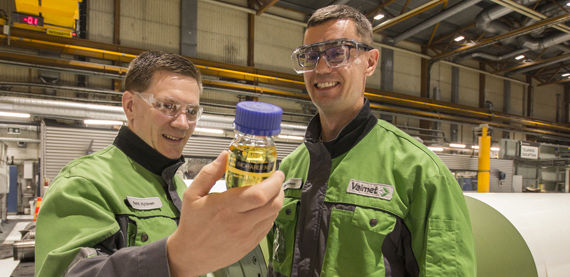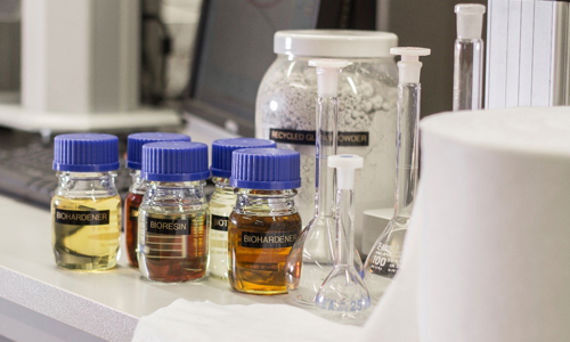Roll covers from recyclable and renewable raw materials
Oct 9, 2019
Could roll covers be made of recycled or even bio-based materials? With less than two years' intensive R&D work, Valmet has taken a remarkable step toward a more sustainable era in the field of production consumables in paper making.

Roll covers used in paper, board, tissue and pulp making need periodical renewal and thus consume tonnes of material resources. A major part of the raw materials used in roll covers – polymers, resins and other industrial chemicals – has traditionally been manufactured from fossil-based raw materials, and refined and processed from crude oil. The manufacturing methods for these raw materials may also have been energy consuming. Old roll covers have ended up in landfill or as energy waste.

“Lignin, carbon black made of lignin and nanocellulose are good examples of by-products that can be utilized as reinforcing fillers in roll covers,“ states Jani Turunen, Manager for Roll R&D, Valmet (right) pictured with Pertti Hytönen, R&D engineer, Valmet.
A more sustainable future with a new generation of roll cover materials
Safety has always been the highest priority, and over the years Valmet has frequently replaced raw materials in roll cover production with safer alternatives. Where raw material selection was previously heavily guided by worker safety, Valmet is now taking a giant leap toward a more holistic approach with a focus on sustainability, aiming to replace as many of the roll cover raw materials as possible with more sustainable alternatives. The target is to use recycled materials and renewable resources, and more broadly to save energy.
Using recycled consumer plastic or glass as the reinforcing fiber or filler in composite roll covers, or bio-based resin and hardener in the polymer matrix, are good examples. The benefits of recycling are easy to understand, but what about bio-based materials?
“They remove the dependency on crude oil,” states Dr. Jani Turunen from Valmet. He continues: “We only approve renewable materials derived from non-food chain plants or plant parts, meaning their use does not affect global food production. Cultivation and harvesting of plants must not endanger the growth of natural forests either. In the best cases, bio-based materials can be produced from plant parts that would otherwise be waste. Lignin, carbon black made of lignin and nanocellulose are good examples, and all three can be utilized as reinforcing fillers in roll covers.”
The target is to produce roll covers based on 100% recycled or bio-based raw-materials.
Innovativeness and a strong R&D pay off
After less than two years of intensive R&D work for sustainable roll covers, Valmet is ready to present the first more sustainable composite covers for press, guide and calender rolls. The content of recycled or bio-based raw materials is between 75 and 96 percent in these covers, but new materials are being continuously tested, and the target is to reach 100 percent as soon as possible.
Work is also being done on polyurethane and rubber covers, and their first customer prototypes may already be available later this year. Last but not least, studies are also ongoing on how the scrap material from removed covers can be optimally recycled or utilized.
“We’ve already been in touch with companies that are breaking the rubber (tires) down back to oil, carbon black and fuel with the help of their pyrolysis process. The carbon black could then be recycled to produce new rubber roll covers,” reveals Turunen concerning Valmet’s future plans.

The share of recycled or bio-based raw materials in the new composite covers for press, guide and calender rolls is currently between 75-96%.
No need for compromise
When we’re talking about more sustainable alternatives and recycled products, it’s relevant to ask about product performance. Valmet’s R&D work shows very promising results here too.
“We were actually surprised with the laboratory results we obtained from these sustainable covers. Some of the properties, like wear resistance, were even better than with our standard roll covers,” says R&D Engineer Pertti Hytönen with a broad smile. “Of course, we’re still at the beginning, and creating products as good as our state-of-the art offerings may take a few years. But even in those products at least some of the raw materials can already be replaced with more sustainable options.”
Examining the most important roll cover properties and requirements – for example, in the results achieved in pressing or calendering – shows that users don’t need to compromise on product performance.
Make a difference to our environment
To summarize, the benefits of sustainable roll covers are clear: good performance in the papermaking process and a solid way for paper companies to prove they are acting to make planet Earth a better place for future generations.
TEXT Jani Turunen, Juha Ruotsi
PHOTOS Joonas Nieminen
Related content




